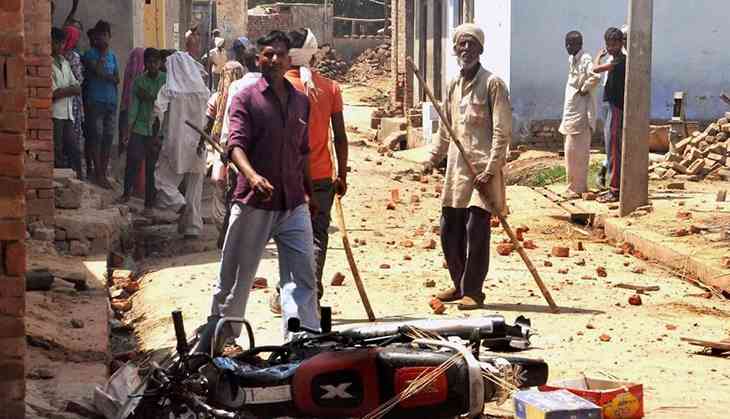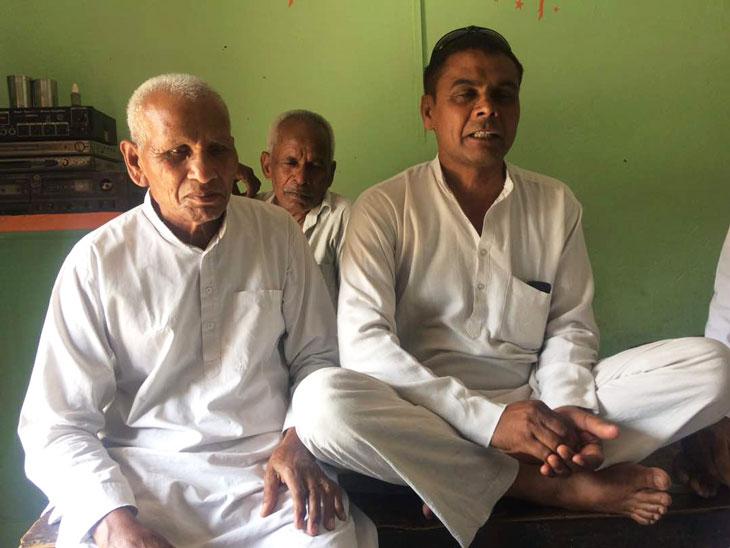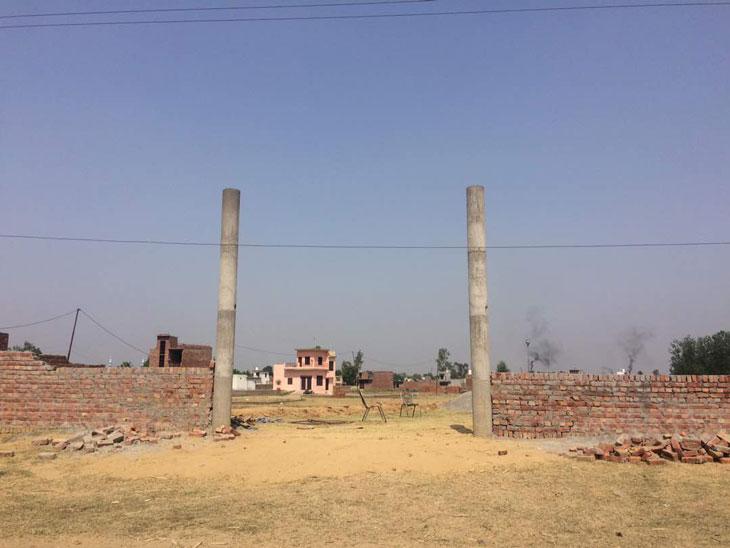Ground Zero Saharanpur: We were Hindus only till polling, Dalits complain

“When the elections come around, we are seen as Hindus. But as soon as they end, we again become chamars, jhimars, valmikis,” Lokesh Kumar, a Dalit, says, as we chat under a tree in the courtyard of the Ravidas Hostel in Saharanpur.
Lokesh, one of almost 80 students who stay in this 16-room building, is preparing for a teaching job.
Monu Kumar, another student pursuing MSc at a local college, reluctantly pitches in: “We also voted for the BJP. See what they are doing to us.”
The tension is palpable as more residents come out to the courtyard.
The Ravidas Hostel, painted in yellow and white colours, a reminder of Raj Era architecture with semi-circular arches, was established in 1952. A Ravidas temple seems to have come up later at its entrance – the glossy tiles on its walls are a mismatch to the older building.
Since Tuesday, when a mob said to be hundreds strong, engaged in arson in multiple places on the periphery of the Saharanpur city, attacking police, members of the district administration, and even mediapersons, the mention of the hostel inadvertently comes up in most conversations about the incident.
The Bhim Army
The mob, comprising of mostly youth, belongs to a group which calls itself the Bhim Army. Some locals call Ravidas Hostel, 'the adda' for all the planning and the venue for the meetings of the organisation.
The Tuesday violence which followed the May 5 incident in Shabbirpur village, exposed the divide in this deeply casteist region. It also comes on the heels of the municipal elections.
In Shabbirpur, a village with a sizeable population of both the Dalits and the Thakurs, violence erupted after Dalits attacked an unplanned procession of Rajputs celebrating Maharana Pratap Jayanti. In retaliation, several Dalit houses were burnt by the Rajputs in the two villages of Shabbirpur and Maheshpur.
The Tuesday violence by the Bhim Sena, the armed group claims, was a result of the angst against the partisan attitude of the administration against the Dalits. The group is headed by one Chandrashekhar, a lawyer, and claims to have more than 40,000 members in multiple states. The figure may be an exaggeration, locals point out, as most of them are not even aware of its existence.
Youth at the Ravidas hostel, meanwhile, seem to be reluctant to talk about the Bhim Army. Most of its members have gone underground since the Tuesday incident. The organisation faces more than two dozen criminal cases now. SSP SC Dubey says the police has activated all its wings, including the ATS, the STF and the intelligence branches, to go to the root of the incident. A few, high value, strategic arrests, as he put it, are likely in the coming days.
“If a Dalit woman is attacked, it is seen as a routine incident. If a Brahmin is attacked, it makes to prime time and front pages. Why?” Karamchand, who deals in-second hand cars asks this reporter. “Why is it that no compensation was announced for those Dalits whose houses were torched? Is it not a bias?” he says.

The Shabbirpur incident
The 5 May violence in Shabbirpur has a background. The locals wanted an Ambedkar statue installed at the entrance of the village, something which was opposed by the local Thakurs.
“The Dalits houses are the first ones at the entry,” says Nathi Singh, vice-president of the All India Kshatriya Sabha. “It was opposed by the Rajputs for they were not comfortable with such a big statue at the entrance,” Singh claims.
So when on 5 May, the Thakurs, not just from the nearby villages but also from other districts, were heading to Simlana to take part in the Maharana Pratap Jayanti celebrations, “dancing and singing” and even wielding “weapons” as some local eyewitnesses claim, the procession was attacked with stones by the local Dalits. Sumit, from Rasoolpur village, succumbed to his injuries.
It must be noted here, that celebration of Maharana Pratap's birthday by the Rajputs in this region is around a decade old phenomenon and growing aggressively. "Since a section started celebrating Vishwakarma Jayanti, and Brahmins started celebrating Parshuram Jayanti, Rajputs rediscovered their hero," Sukhbeer Singh Pundeer, a former BJP MLA, explains.
As soon as the news got to Simlana, a mob of Thakurs is reported to have descended on Shabbirpur village, torched houses, even desecrated the local Ravidas temple. Singh, however, claims that Dalits set their own houses on fire.
In the last Panchayat elections, a Dalit had won, for there were many Rajput candidates in the fray. The Dalit sarpanch is said to have warned the local police of the consequences if the Maharana Pratap Jayanti procession were to pass through the village. The police did not pay much heed and just deployed two constables, according to Singh. As the Sarpanch feared, the procession was attacked.
“It became a battle of egos,” a senior police officer in the district says.
“Samman ka badla samman, apmaan ka badla apmaan,” is how Karamchand puts it in village Ramnagar. “The Rajputs can't handle that the Dalits now have money and political voice.”
Why Ramnagar?

Ramnagar is also where all hell broke loose on Tuesday, as the mob went on a rampage after being denied permisssion to hold the “chamar mahapanchayat”, a protest meet, at the Gandhi park in the city. The walls of the under-construction Maharana Pratap Bhawan were also brought down by the mob.
“Bhim Sena seems to have chosen Ramnagar carefully, for the villages here are all dominated by Dalits,” says Khazan Singh, another Dalit from the Ramnagar village. Multiple police jeeps guard the entry points to the village. “Most of the villagers have run away to the fields or other villages fearing police action,” Singh informs, pointing to the shops with their shutter down and empty lanes.
“We could have fired, but we chose not to. Any Dalit death would have snowballed into a big nationwide issue,” a senior police officer says, as he directs more FIRs to be registered against the group.
“What option do we have if the police does not support us?” Karamchand asks. “Bhim Army will protect us if the police decides to be on the other side.” He claims that the Rajputs have become more aggressive after Yogi Adityanath, a Rajput, was sworn in as CM. “They think he is one of their own.” The police, meanwhile, arrested 10 Rajputs for the Shabbirpur incident.
BSP involved?
Saharanpur has been a BSP stronghold. It was only in the just-concluded elections that the BSP did not win even one Assembly constituency.
Pundeer says the violence is a result of the unease amongst the BSP leaders. They are provoking the youth, he claims, insisting that even the Bhim Army has links to the BSP leaders. “Bhim Army is a group of gundas egged on by the BSP leaders, including a former MLA,” he says.
“They lost the backward vote, the Muslim vote, most of the Dalit vote. They are just left with the Jatav vote,” Pundeer says. “The BSP wants a rift between the landless farm labourers and the farmers,” he says, claiming that it was the only formula left with the party to keep its remaining flock together and counter the BJP, which aggressively vies for the Dalit vote. “BJP, Modi and Yogi want the Harijan to become Hindu,” he explains.
The explanation does not find any takers at the Ravidas hostel. “There were no such issues in the SP and the BSP governments. It's difficult to read what going on in the minds of this new state government,” Manoj Kumar says. He explains how the local MP, Raghav Lakhanpal, tried to use the Dalits to rake up an issue with the Muslims over the Ambedkar Jayanti celebrations in Sadak Doodhli village earlier last month. The incident was handled well by the local police, much to the anguish of the local MP.
Lokesh Kumar, meanwhile, says, now there are rich and poor people in all communities, suggesting how a class of affluent people have come up among the Dalits. “They don't want to be suppressed anymore,” he says.
And Bhim Army? “The Dalit politicians were not doing enough,” Monu Kumar says. “Political leaders have their limitations. They could not hit the street to take up our issues,” he tries to explain how this created space for the Bhim Army.
Can an outfit like this replace the BSP in the longer run? “BSP is in our blood. Bhim Army is just a social outfit,” Monu Kumar says.
First published: 11 May 2017, 22:51 IST
